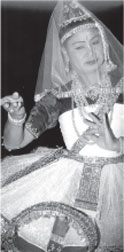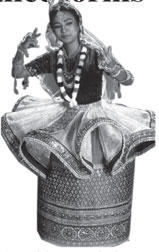Royal patronage for Indian classical dance forms
By Subashini. PATHMANATHAN
The Indian classical dance forms are closely linked to Hindu
tradition and influenced by Hindu religion, and based on Natya Shastra.
Most of the Indian classical dances had their origin in the temples and
the temple environs. In one way or another dance forms enjoyed the royal
patronage. Sathir dancers were given full support and encouragement by
various kings, at different periods. The kings themselves, engaged the
dancers to serve in temples, and provided all the facilities, to
continue their services. Later these temple dancers became court
dancers. Especially, during the Chola period there is evidence, which
provides a wealth of information about temple dancers, and court
dancers. In the royal courts, the poets, who composed songs, were called
Asthana Vithakars, and those who composed the music for the poems, were
called Asthana Kavijars, and those who danced for poems were called
Asthana Narthakis.
 |
|
Manipuri dancer |
Similarly, another Indian classical dance form is Kathakali.
Kathakali, originated in royal courts, and later it moved to the
temples. Before the birth of Kathakali, Chakkaier Koothu was more
popular, what is now known as the Kerala State . It was performed by the
male members, of a particular caste called Chakkaier who had the
hereditary right to perform. The basic theme of the dance was gathered
from epics, and puranas.
Kathakali had its origin from Krishnaatam, during the reign of king
Maanadevan of Calicut in the 17th century. The Krishnaattam was based on
lord Krishna 's stories. The literature for Krishnaatam was in the
Sanskrit language. The Kottakari king of south Kerala, requested
Maanadavan to stage the Krishnaatam at his court. Due to the refusal of
Maanadevan, the brokenhearted King Kottakari Raja, introduced
Ramaraatam, which was similar to Krishnaattam, but the story was based
on Lord Rama, the poetic verses were in the regional language Malayalam.
In the Ramaraattam, exquisite facial expressions, beautiful hand
gestures, were used, sidemen call accompaniments were employed. In later
years, this dance form adopted various themes including other Puranas
and Ithikas stories. Firm vigorous movements, Thandava stances, subtle
Lassiya movements, various martial techniques, were introduced. With the
passage of time, the name Krishnaattam, and the name, Ramaraattam
disappeared, and the dance form gained the name Kathakali. Royal
patronage, was given by the rulers, especially by the Travancore rulers,
namely Balarama Varma, and Swaathithirunal Maha Raja.There is evidence
that in the Travancore Palace Kathakali troupes were available to
perform regularly.
The north Indian classical dance form Kathak, derived its name from
the word, Katha. Katha means story. Kathakar (storytellers) belonged to
a particular caste, which was actually responsible for the development
of this dance form, and Kathak was attached to the temples. The firm
development of Kathak dance form, originated during the15th century. The
main theme or stories in this dance form were on Radha, Krishna themes,
with bakthi cult. Mostly, the Radha Krishna bakthi cult was based on the
dramatic play call Rasalila.This dance form included melodious music,
beautiful rhythmic dances, and dramatic narrations in between the dance.
During the period of Muslim reign, this dance form moved from temples to
courts. Initially it developed in two different regional and religious
courts. One was in the Muslim courts, and other was in the Hindu courts.
Anyhow, in both courts this dance form was cherished and preserved with
the same spirit as a stylized entertainment.
In Rajasthan Hindu, royal courts gave more prominence to nirtha
aspect (pure dance movements). Meanwhile in the Muslim courts in Delhi ,
Agra , and Lucknow , the dance form developed with normal life moods,
and life passions. Hence, naturally it gave more importance to
expression, Bhavas, and Rasas in Jaipur. The execution of this art form
gave birth to two different styles. One is the Jaipur style, and other
is the Lucknow style. The devotional music kirthans, during the period
of the Moghal emperors the Khayal, Drupad, Thumpri and Ghazal were the
musical concepts, introduced as the musical base for this art form. In
the19th century, during the reign of King Wajid Ali, the Lucknow style
gained recognition and the king gave full support and encouragement for
the development of this art in his royal court. One of the main founders
of this style was Thakur Prasad and his three sons served in the court
of King Wajid Ali. The style differences as in any art form are the
masterwork of different gurus of different areas. (Without changing the
basic concepts of the art form).
The king of Raigarh of Madya Pradesh, Chakraradhar Singh, gave the
royal patronage to both styles of kathak. Both these styles have
beautiful aesthetic essence and attractive stances.
Manipuri dance like all other Indian classical dance forms has its
roots, in deep devotion, and spiritualism. The King Bhagaya Chandra was
a famous king who ruled Manipur during the period of 1759 to 1798 A.D.
He was deeply involved in culture and religion. He himself excelled in
prose, poetry, philosophy, dance, drama, and music. The kings and the
queens were very much involved, with the traditional art forms, mainly
dance and music. Even the queen herself danced with the public, in the
same public places, and the common masses were not restrained from
seeing the performances. Generally, the dance was common to all; there
was no barrier for caste or creed. The dance was not practised just for
mere entertainment, but with deep dedication and devotion. After the era
of king, Bhagaya Chandra, the kings in his lineage, gave full support,
and patronage for the dance, and other art forms.
 Even the development of thalas in Manipuri is still identified with
the rule and period of individual kings. Even the development of thalas in Manipuri is still identified with
the rule and period of individual kings.
Odissi, another classical dance form, received full royal patronage
by different kings of different eras. According to one of the
inscriptions, during the king Kharavela, of second century B.C,
encouraged the dance and music forms, by carving the figures of dancers
and musicians in the caves.
The Jaganath temple of Puri was built up, during the reign of King
Chodaganga Deva, who belonged to Ganga dynasty and his dynasty lasted
more than four decades. (The Ganga dynasty lasted for more than four
centuries). Chodaganga Deva introduced the Maharis (devadasis) to serve
in the Lord Jaganath temple, at Puri. Still his contribution to the art
is recognised and remembered in Orissa, (earlier Orissa was called Orda
Desh).Interpreting the meaning of the songs through dance was generally
done through hand gestures, and facial expressions. This type of
interpretation of songs through dance was introduced in Odissi, during
the Suriya Dynasty.
During this period, the Maharis were trained to perform dance inside
the temples. The minister Mahakeswar Mohatra of King Narayanadeva's
court wrote 'Abinaya Chanrika', which is still considered as a complete
work on Odissi dance. Later the Odissi dancers were divided into three
different categories, one was temple dancers, Maharis, other was the
royal court dancers, Nachunis, and the other was the Gothipus, the male
dancers who performed before the public. With the passage of time due to
the political changes, mainly during the Muslim and alien rule the dance
lost the religious values, and the art was persevered for entertainment.
Generally, most of the Indian classical dance forms enjoyed the royal
patronage to some extent. Due to the royal patronage and encouragement
all, the Indian classical dance forms have developed and acquired
worldwide recognition today.
|

